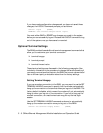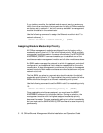3 - 14 ONline Ethernet Management Module Installation and Operation Guide
Note: When you use the IP Address entry of all, you cannot use
trap, read_trap, or all access.
The three “old” trap options should be used when sending traps to
workstations using the 3Com MIB I variables. All the non-”old" trap options
should be used when sending traps to workstations using the 3Com MIB II
variables.
An EMM sends alarms to those IP addresses in the community table having
either trap, read-trap, or all attributes. The EMM and all modules in the
concentrator can be configured via SNMP from stations having IP addresses
with either read-write or all attributes. Finally, the EMM can be monitored
from stations having IP addresses with read-only, read-write, read-trap, or
all attributes.
An EMM can receive SNMP alarms from SNMP devices on the network
(including itself) once the EMM's IP address and accompanying attributes
have been added to the community table of the SNMP device generating
the alarms, and the SET ALERT feature is enabled.
For example, if a major fault condition causes a port to be disabled, an
SNMP alarm is generated and displays to the terminal or workstation. This
feature enables you to analyze network information simply by accessing a
single EMM instead of having to be at the network management
workstation.
If you plan to manage your concentrator through an SNMP workstation,
you must set the following attributes for the EMM:
❑ IP Address
❑ Community Table
❑ Alerts
❑ Subnetwork Mask
❑ Trap Receive
❑ Default Gateway


















